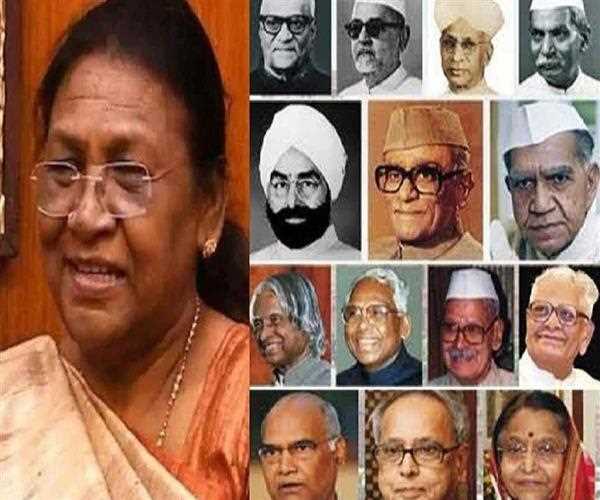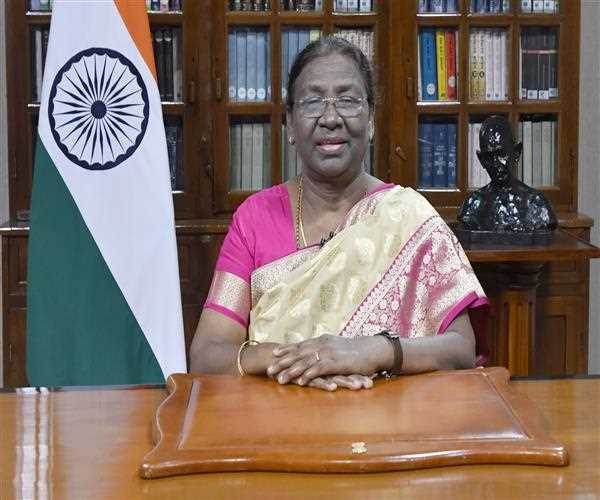Search here

24-Jul-2023 , Updated on 7/24/2023 10:45:06 PM
Explore the list of presidents in India
Highlights
- The President of India is the head of state and the constitutional head of the Indian government.
- The President is elected by an electoral college consisting of elected members of both houses of Parliament and the legislative assemblies of the states.
- The first President of India was Dr. Rajendra Prasad, who served from January 26, 1950, to May 13, 1962.
- The President's term is five years, and a person can hold the office for a maximum of two terms.
- There have been several notable Presidents, including Dr. Zakir Husain, the first Muslim President, and Dr. APJ Abdul Kalam, a renowned scientist and often referred to as the "Missile Man of India."
- The current President (as of my last update in September 2021) is Ram Nath Kovind, who took office on July 25, 2017.
- The President's role is largely ceremonial, but they play a crucial role in the functioning of the government, including appointing the Prime Minister and other high officials.
- In case of a vacancy in the office of the President, the Vice President acts as the President until a new President is elected.
- The official residence of the President of India is Rashtrapati Bhavan, located in New Delhi, a historic and grand building designed by Sir Edwin Lutyens.
- India has had a diverse set of Presidents, including scholars, politicians, and eminent personalities from various fields.
The President of India is the head of state and the first citizen of India. The President is elected by the Electoral College, which consists of the members of Parliament and the members of the state legislative assemblies. The President's term of office is five years.
The following is a list of all the Presidents of India, along with their political affiliation, date of election, and date of death-
| President | Political affiliation | Date of election | Date of death |
| Dr. Rajendra Prasad | Indian National Congress | 26 January 1950 | 28 February 1963 |
| Dr. S. Radhakrishnan | Indian National Congress | 13 May 1962 | 17 April 1975 |
| Zakir Husain | Indian National Congress | 24 August 1969 | 3 May 1969 |
| Varahagiri Venkata Giri | Indian National Congress | 20 July 1969 | 24 August 1974 |
| Fakhruddin Ali Ahmed | Indian National Congress | 24 August 1974 | 11 February 1977 |
| Neelam Sanjiva Reddy | Indian National Congress | 25 July 1977 | 1 January 1996 |
| Giani Zail Singh | Indian National Congress | 25 July 1982 | 25 September 1994 |
| R. Venkataraman | Indian National Congress | 25 July 1987 | 24 April 2009 |
| Shankar Dayal Sharma | Indian National Congress | 25 July 1992 | 26 December 1999 |
| K.R. Narayanan | Indian National Congress | 25 July 1997 | 9 November 2005 |
| A.P.J. Abdul Kalam | National Democratic Alliance | 25 July 2002 | 27 July 2015 |
| Pratibha Patil | Congress | 25 July 2007 | 22 July 2012 |
| Pranab Mukherjee | Congress | 25 July 2012 | 31 August 2020 |
| Ram Nath Kovind | Bharatiya Janata Party | 25 July 2017 | 24 July 2022 |
| Droupadi Murmu | Bharatiya Janata Party | 25 July 2022 | Incumbent |
Notable achievements of the Presidents of India
The Presidents of India have made significant contributions to the development of the country in a variety of fields. Some of their notable achievements include:
- Dr. Rajendra Prasad was a key figure in the Indian independence movement and played a leading role in the drafting of the Constitution of India.
- Dr. S. Radhakrishnan was a renowned scholar and philosopher who promoted the values of Indian culture and spirituality.
- Zakir Husain was a champion of education and social justice who helped to improve the lives of millions of Indians.
- Varahagiri Venkata Giri was a strong advocate for human rights and social reform.
- Fakhruddin Ali Ahmed was a dedicated public servant who worked tirelessly to improve the lives of the people of India.
- Neelam Sanjiva Reddy was a consensus builder who helped to promote national unity and harmony.
- Giani Zail Singh was a champion of the rights of the poor and marginalized.
- R. Venkataraman was a distinguished administrator who helped to strengthen the institutions of democracy in India.
- Shankar Dayal Sharma was a respected statesman who promoted peace and understanding between India and its neighbors.
- K.R. Narayanan was a scholar and diplomat who raised the profile of India on the international stage.
- A.P.J. Abdul Kalam was a visionary leader who inspired millions of Indians with his passion for science and technology.
- Pratibha Patil was the first woman to be elected President of India. She worked to promote women's rights and empowerment.
- Pranab Mukherjee was a veteran politician who served as the Finance Minister of India for several years. He was a strong advocate for economic growth and social justice.
- Ram Nath Kovind was the first member of the Dalit community to be elected President of India. He worked to promote the rights of the marginalized and disadvantaged.
- Droupadi Murmu is the first tribal woman to be elected President of India. She is a champion of the rights of Droupadi Murmu is the first tribal woman to be elected President of India. She is a champion of the rights of the tribal communities and has worked to promote their development.

The Presidents of India have played a vital role in the growth and development of the country. They have been the custodians of the Constitution and have worked to uphold the values of democracy and secularism. They have also been the symbols of national unity and have worked to promote peace and harmony among the people of India.
Challenges faced by the Presidents of India
The Presidents of India have faced a number of challenges during their tenure. Some of the challenges they have faced include-
- Communal tensions- The Presidents have had to deal with the issue of communal tensions on a number of occasions. They have worked to promote communal harmony and have called for peace and understanding between different communities.
- Economic challenges- The Presidents have also had to deal with the economic challenges facing the country. They have worked to promote economic growth and have called for policies that will benefit the poor and marginalized.
- Political instability- The Presidents have also had to deal with the political instability that has plagued the country on a number of occasions. They have worked to ensure that the democratic process is not disrupted and have called for unity and stability.
- Natural disasters- The Presidents have also had to deal with the natural disasters that have struck the country from time to time. They have worked to provide relief to the affected people and have called for measures to prevent such disasters in the future.
Role of president to serve indian economy
- Appointing the Finance Minister- The President appoints the Finance Minister, who is responsible for the country's economic policies. The President has the power to choose a Finance Minister who is committed to economic growth and development.
- Approving the Union Budget- The Union Budget is the most important economic document of the year. It sets out the government's spending plans for the coming year. The President has the power to approve or disapprove the Union Budget
- Promulgating ordinances- In case of an emergency, the President can promulgate ordinances. Ordinances are like laws, but they do not need to be passed by Parliament. The President can use ordinances to take quick action to address economic challenges.
- Addressing Parliament- The President addresses Parliament at the beginning of the Budget session. In his address, the President outlines the government's economic priorities for the coming year. The President's address can help to shape public opinion on economic issues.
- Representing India on the international stage- The President represents India at international summits and other events. In these forums, the President can promote India's economic interests and attract foreign investment.
The President's role in the Indian economy is not limited to these formal powers. The President can also use his or her influence to promote economic growth and development. For example, the President can meet with business leaders and urge them to invest in India. The President can also speak out in support of economic reforms

SEO and Content Writer
I am Drishan vig. I used to write blogs, articles, and stories in a way that entices the audience. I assure you that consistency, style, and tone must be met while writing the content. Working with the clients like bfc, varthana, ITC hotels, indusind, mumpa, mollydolly etc. has made me realized that writing content is not enough but doing seo is the first thing for it.
Join Our Newsletter
Subscribe to our newsletter to receive emails about new views posts, releases and updates.
Copyright 2010 - 2025 MindStick Software Pvt. Ltd. All Rights Reserved Privacy Policy | Terms & Conditions | Cookie Policy